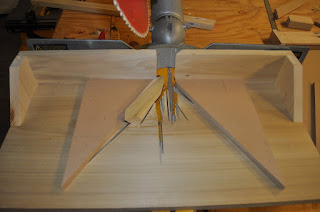This model is the Tetrahedron (3 equilateral triangles at each vertex) . See my last article on the geometry of the Platonic Solid Tetrahedron for the angles of the Platonic Solid.
I was trying to see if it was possible for Leonardo da Vinci (1452-1519) to have made wooden polyhedra models having solid edges for his illustrations in Luca Pacioli's 1509 book The Divine Proportion. Conclusion, no. He might have made wooden polyhedra models out of twigs, but to have cut all the edge pieces exactly would have been beyond his tool-man-ship. This Platonic Solid Tetrahedron has 6 edge pieces. That's 6 x 4 = 24 compound cuts on the wooden model. In his Dodecahedron model / drawing it would been 30 x 4 = 120 compound cuts on the wooden model and all of them would have to be exact. If the compound cuts on the wooden model are not exact, then you'll never be able to put all of the pieces together. This isn't even counting the 30 x 2 = 60 edge bevels, hip rafter backing.
Leonardo da Vinci's Polyhedrahttp://www.georgehart.com/virtual-polyhedra/leonardo.html
1: Rip 6 pieces of wood to the same dimension. In this model I had 4x4 redwood post left over from a job and I ripped them to 2 1/2 x 2 1/2.
2: Cut a scrap of wood to 35.2°. This is half of the Dihedral angle.
3: Use the scrap of wood to set the table saw blade tilt to 35.2°.
4: The hip rafter backing angle is 54.73572°. Since the table saw blade tilt is limited to 45° we're ripping the material with the blade tilt at 35.2° , half of the Dihedral angle, on both sides of the material to form the Dihedral angle on each edge piece of the Tetrahedron. This is the same as backing out the hip rafter.
5: Check the Dihedral angle. It should be 70.5°.
6: Set the blade tilt of your miter saw to 45° and the miter to 45°. These two angles are for cutting the edge piece on the top edge of the material. If we were cutting the edge piece on the side of the material, like we do with hip rafters, then we would use 54.73561° as the miter angle and 30° as the saw blade bevel tilt. It would result in a compound bevel angle of 45.00°.
7: Cut one end of each of the 6 edge pieces of the Tetrahedron.
8: Setup a stop on the miter saw. All the edge pieces of the Tetrahedron must be exactly the same dimension.
9: Reverse the edge piece and cut the other end using the stop.
10: Assemble the 6 edge pieces. Assemble the 3 bottom pieces first. This will tell you if your miter angle and blade tilt were exact.
In this photo you can see one edge of the tetrahedron model does not fit perfectly. This is due to the blade tilt or miter angle not being exactly 45°.
These pictures make it look easy to build the platonic solid, but it's not. Assembling the 6 edge pieces perfectly is harder than cutting the 6 edge pieces.
Platonic Solid Icosahedron
With the material laying flat on the compound miter sawYour miter angle is = 31.71747°
Your Saw Blade Bevel Angle = 54.00°
or you can cut the material on edge in your compound miter saw using
Saw Miter Angle = 58.2825°
Saw Blade Bevel Angle = 18.00°
Left and right miter angle jigs for Icosahedron.
The saw miter and saw blade bevel angles for the Icosahedron are beyond the capabilities of most compound miter saws. You will have to build a jig to cut the edge pieces of the Icosahedron.It's been a couple of years since I built the Icosahedron, but I think the jig triangles are 30° - 60° triangles and the saw miter angle would be 58.2825° - 30° = 28.2825° with a saw blade bevel angle of 18.00° for cutting the edge pieces on edge in the compound miter saw.
Roof Framing Angles
for the
Great Pyramid
Hip Rafter Backing Angle
33.78620°
also used for the plywood
saw blade bevel angle


















No comments:
Post a Comment
Note: Only a member of this blog may post a comment.